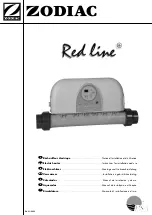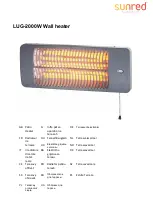
www.alfrescoheaters.ie
10
5.
Slide the cable lug onto the threaded stud.
6.
Slide one lock washer next to the lug and then replace the outer nut.
You can refer to the following picture to see the order in which they should be placed.
Installing the cable lug,
lock washer, and
element nuts
7.
Using one of the provided spanners, hold the inner nut in place.
8.
Using the other spanner, tighten the outer nut securely against the lug and lock washer.
Warning!
If you do not tighten the element nuts very securely, the lugs will overheat and melt,
causing possible injury and property damage. Also, if the element nuts are not sufficiently
tightened, this will void the manufacturer’s warranty.
9.
Repeat this process for the opposite end of the element.
10.
If you are installing a dual element heater, repeat this process with the second element.
Note:
For dual element heaters, ensure that you connect the ends of the element to the
appropriate cables. If you connect one end of the element to the cable marked L (refer to the bright
yellow tags on each cable), you must connect the other end to the cable marked N. Similarly, attach
one end of the second element to the cable marked L1 and the other end to the cable marked N1.
This is to ensure that each element has one live and one neutral connection.
To complete element installation:
1.
Replace the element end covers and secure them using the screws you removed earlier.
2.
Replace the grille and secure it using the screws you removed earlier.
3.5.
Wiring the Heater
Warning!
Only qualified electricians should carry out the electrical wiring of the heater. Otherwise, there is
a serious risk of electric shock.
As noted in the precautions under
Important Safety Instructions
, you should only install this appliance on a
230-240 volt AC single phase electricity supply. When installing several heaters to a location where 3-phase
Outer element nut
Cable lug
Inner element nut
Lock washer

































